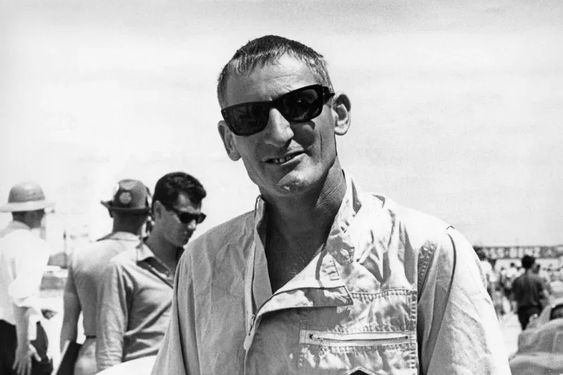While the name Carrol Shelby is so much more recognizable to many racing fans, true motor sports enthusiasts hold another name in equal prestige: Ken Miles.
Prior to the release of 2020’s Ford vs. Ferrari, a semi-fictionalized account of the legendary rivalry between the two manufacturers and how they went head-to-head in the 1966 Le Mans 24 hours, Ken Miles wasn’t a name automatically associated with motor sports; after all, the British engineer and Shelby’s teammate preferred it that way when he was alive. For Ken Miles, racing was all about the machine, and he loved what he did while he did it.
Ken Miles: Early Life
Engineer Ken Miles was born in Sutton Coldfield in England back in 1918, just 10 miles north of England’s then-industrial city of Birmingham. Ken’s love affair with cars started early when, at the tender age of 11, he started racing 350cc Triumph motorcycles. On one particular race, the barely pubescent Ken crashed his motorcycle, breaking his nose and losing three teeth. Rather than be deterred or turned off from racing in general, the crash only furthered Ken’s love for racing, encouraging him to buy an even bigger motorcycle.
At the age of 15, Ken Miles built one of his first racing cars: an Austin 7 Special he christened “Nellie”. Nellie became one of the blueprints for Ken’s future designs, with many of the mechanical modifications he implemented on the Austin 7 becoming a signature engineering style during his racing career. As the Second World War broke out, Ken enlisted and served in the British Territorial Army, where his natural talent for tinkering was put to good use. During his time in the British Armed Forces, Ken Miles worked in Tank Recovery, a job that involved salvaging tanks and repairing them back to operational usage.
The Love Between Ken Miles, Engines, and Racing
It was his time in the army that allowed Ken Miles to further study and hone his engineering skills, particularly in the field of engine technology. In letters he sent to Motorsport Magazine, a historical British publication dedicated to motoring, Ken went into specifics about his undying love for engines, why he was so enamored by their inner workings and how he saw potential in every engine he has worked it. It was in these letters that a young Ken Miles would share his dream of one day designing and building his own version of a supercharged engine.
An important lesson he learned in his time in the army was physical fitness, a practice and mindset that was practically overlooked prior to his involvement in racing. When he started working for some of the then-biggest racing firms, Ken Miles insisted that drivers follow a strict physical fitness regimen that kept their bodies as sharp as their minds, a practice that we still hold true today.
Today, Ken Miles is best remembered as one of the most influential engineers of his era. In fact, Ken sees himself more of a mechanic than a driver, a fact that he underlines in the A.J. Baime’s book Go Like Hell: Ford, Ferrari, and Their Battle for Speed and Glory at Le Mans when he says:
“I am a mechanic. That has been the direction of my entire vocational life. Driving is a hobby, a relaxation for me, like golfing is to others.”
During the height of the Ford-Ferrari feud, the American manufacturer hired Ken as both a test driver and as competition director for Shelby-American, a position that allowed him to fully practice both his love for engines and his love for racing. It is here, in collaboration with his friend, teammate, and legendary racer Carroll Shelby, that they were able to create one of the most legendary motor sports machines of all time: the Ford GT40.

Photo from Pinterest
Ken Miles: Legacy
Sadly, just two months after their victory at the 1966 24 Hours of Le Mans, Ken Miles met his tragic end when the Ford J-car that he had been testing flipped, crashed, and then caught on fire. The crash threw Ken out of the car and he sadly perished instantly. The Ford J-car was being tested to avoid the kind of accident it had succumbed to, and unfortunately, the damage to the car was so severe that an exact cause for the crash could not be determined, with the chassis almost completely disintegrating on impact.
Carrol Shelby, Ken’s teammate, friend, and confidant, was one of the eyewitnesses to the accident, and was one of the first people to express their grief at the passing of both a dear friend and an amazing engineer:
“We really don’t know what caused it,” Carroll Shelby said. “The car just disintegrated. We have nobody to take his place. Nobody. He was our baseline, our guiding point. He was the backbone of our program. There will never be another Ken Miles.”
Back in the ‘60s, race car drivers faced an unusually high death toll, mostly because of the fairly primitive racing machines that they rode on, so it wasn’t uncommon for a racer to die. However, Ken Miles passing was met with undeniably widespread grief in the motor sport industry, with Carrol Shelby feeling such grief that Shelby-American withdrew from Le Mans racing a year later.
Ken’s death, however tragic, managed to create industry-wide changes to car design, with the Ford J-car becoming a cautionary tale for car manufacturers everywhere, with Ford redesigning the body to have a more conventional, albeit more aerodynamic, shape to mitigate excess lift, a factor that was highlighted as one of the reasons for the deadly crash. Ford also insisted on building a NASCAR-style steel tube rollover cage as further protection, a design change that was brought about by Ken Miles’ death, and a design change that saved driver Mario Andretti’s life when he went through a similar crash a year later. The improved J-car managed to win 2 races: the 1967 Sebring 12 hours and the 1967 24 Hours of Le Mans.
Ken Miles’ love for engines and his dedication to his craft allowed future car manufacturers to create, design, and build racing cars that were safer, faster, and more advanced than anything Miles could have dreamed of back in ’66. But thanks to his sacrifice, motor sports as we know it today has greatly improved.

